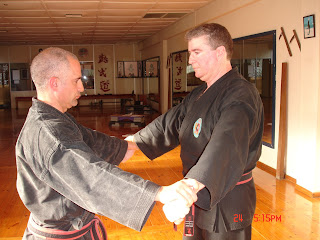26 SEPTEMBER 2013
PLEASE SEE ME AT MY OTHER BLOG
www.clubmasterhoang.blogspot.com
WHAT IS VIET-KHI-PHAP.
VIET-KHI-PHAP is a discipline specialized on the practice of
breathing methods and the development of inner energy, aiming at training the
physical strength of the body and the consciousness for a state of perfect
insight and tranquility.
VIET-KHI-PHAP is a way of Inner Energy. It is an “inward” discipline that employs 5
methods of breathing to the 18 powerful breathing techniques and to the 4 forms
of seasonal movements.
MEANING OF THE TERM
VIET-KHI-PHAP
Viet. To surpass,
to excel, to overcome. Vietnamese people.
Khi. Air, ether, inner energy, vitality, high potential power.
Phap. Method,
way, principle.
Since the name of this discipline is a proper and compound
name it is best to hyphenate it as in VIET-KHI-PHAP or Viet-khi-phap. However, in English as well as in other
western languages it is acceptable to write it in one word as Vietkhiphap.
The compound word Viet-khi-phap has been created from three
separate Vietnamese words by Grand Master Phan Hoang for naming the modernized
discipline he founded decades ago. This Vietnamese discipline is not a version
of any style of Chi-Kung, Qi-Gong, Khi-Cong, Tai-Ji-Quan, Tai-Chi.

ENGLISH VERSION (Le texte en français suit la version en anglais)
THE LAKE TWO MOUNTAINS
From time to time, I have the opportunity to come back and see this large lake to which I gave a Vietnamese name, "Ho Luong Son", reflecting its original name: "Lac de Deux Montagnes" / "Lake Two Mountains."
Every time when I see it, it always provides me with a source of energy and a deep inspiration, whatever the time of the day: morning or night, or the season: winter, summer, fall or spring.
There were moments I stayed a long time at the lake contemplating the immensity of this lake and the sky. Many times in winter, when the temperature outside is minus thirty degrees centigrade, I crossed the lake by car via the "ice bridge", the name given to the iced passage lined with small fir trees between the shore of Oka (Quebec) and the shore of Hudson (Quebec) two kilometers across the lake. Frequently, on snowshoes I walked on this lake, when a thick layer of fresh snow covered its iced surface. One autumn evening, I crossed by boat when it was violently shaken by a strong storm. For me, this lake is both mysterious and unforgettable: it is the birthplace of Viet-Tai-Chi and many other teaching during the eight years of intensive creation and reflection at its shore. Seeing again this lake gives me an inexplicable strength!
Phan Hoang ((25-08-2011)
LE LAC « Luong Son »
De temps en temps, j’ai l’occasion de revenir voir ce lac immense auquel j’avais donné un nom vietnamien : « Ho Luong Son », ce qui traduit son nom d’origine : « Lac de Deux Montagnes » / « Lake Two Mountains ».
Chaque fois quand je le revois, il me donne toujours une source d’énergie et une profonde inspiration, quel que soit le moment du jour : matin ou soir, ou la saison : hiver, été, automne ou printemps.
Il y eut des moments où je suis resté longtemps au bord du lac pour contempler l’immensité paisible de cette étendue d’eau et du ciel. Maintes fois, en hiver par moins trente degrés centigrades dehors, je l’ai traversé en voiture en empruntant le « pont de glace », le nom donné au passage bordé de petits sapins entre la rive d’Oka (Québec) et la rive de Hudson (Québec) à deux kilomètres de l’autre côté du lac. Fréquemment, je me suis promené en raquettes sur ce lac, lorsque qu’une épaisse couche de neige fraîche recouvrait la glace. Un soir d’automne, je l’ai traversé en bateau alors qu’il était violemment agité par une forte tempête. Pour moi, ce lac est à la fois mystérieux et inoubliable : il est le lieu de naissance du Viet-Tai-Chi et de tant d’autres enseignements pendant les huit années de création intensive et de réflexion passées sur son rivage. Revoir ce lac me donne une force inexplicable !
Phan Hoang (25-08-2011)









































